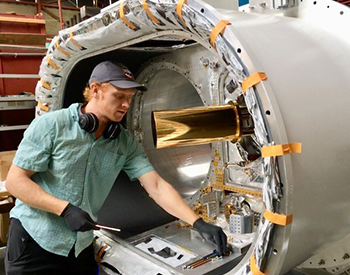Outreaching Science
October 17, 2019 | By Melissa Miller
 Nicholas Galitzki removes the gold-plated shield covering the telescope’s dilution refrigerator. The building and testing phase is underway in the Center for Astrophysics and Space Sciences at UC San Diego. Photo by Melissa Miller, UC San Diego Physical Sciences
Nicholas Galitzki removes the gold-plated shield covering the telescope’s dilution refrigerator. The building and testing phase is underway in the Center for Astrophysics and Space Sciences at UC San Diego. Photo by Melissa Miller, UC San Diego Physical Sciences
Whether designing and building cutting edge technology, mentoring students or communicating the importance of science to the broader community, Nicholas Galitzki represents the next generation of astrophysicists. First inspired by science outreach programs and photos from the Hubble Space Telescope and Voyager Missions, this UC San Diego postdoctoral scholar who studies the universe’s earliest light can’t help but shine enthusiasm for science.
“I got into outreach because that’s how I got into astronomy,” said Galitzki. “Outreach efforts reached me, so I want to give back and inspire the next generation.”
Galitzki volunteers for the Fleet Science Center’s popular “Two Scientists Walk into a Bar” events, answering people’s questions about space as best he can. He also helps organize “Astronomy on Tap San Diego,” where researchers give talks and engage with the public at a local brewery.
Additionally, he often sets up his own personal telescope at these events and a line instantly forms.
“Public astronomy can be very approachable,” Galitzki said. “It’s pretty affordable. My first telescope was one my parents got from Costco.”
He is also a member of the League of Extraordinary Scientists and Engineers, which brings science experiments to local schools. The group also hosts other events, including a panel of experts at San Diego Comic Con every year that Galitzki has participated in along with other UC San Diego researchers.
At UC San Diego, Galitzki works with Professor of Physics and Cosmologist Brian Keating. Galitzki designed and is now building and testing the so-called “first-light” telescope for the Simons Observatory, which will be located on a high mountaintop in Chile. It will be the first of four telescopes installed in the array that will be used to study the origins of the universe. With Keating as the observatory’s director, there are over 30 institutions involved in the worldwide collaboration.
“It’s a cool opportunity,” said Galitzki. “To work with a really capable group of people, to sit down and think about ‘If we have the resources, which we do, what is the best telescope we can design?’”
The array will focus on cosmic microwave background (CMB) signals, radiation left over from the Big Bang. To reduce noise in the signal, the optics on CMB telescopes must be super-cooled. Galitzki’s cryogenic design requires a dilution refrigerator, a $300,000 part that looks like a futuristic ray gun. According to Galitzki, he has measured temperatures of 7 milliKelvin, which is -459.65 degrees Fahrenheit, just a fraction of a degree above absolute zero.
“When we’re running the dilution refrigerator, it’s one of the coldest things in San Diego,” he says.
Simon’s Observatory has been Galitzki’s focus for more than three years, and it’s just the beginning of the project. The telescope is scheduled to be “on sky” by the end of 2020. It will take hundreds of photographs every second and all of that data will eventually be combined into a single image.
“Once the project goes into regular observations, we’ll have this torrent of terabytes a day,” said Galitzki. “We don’t actually get to the results we want until we’ve been observing for four or five years. Once we have that single picture, we can start doing the science.”
Because Galitzki’s appointment as a postdoctoral scholar is coming to an end, he may not be a part of the telescope’s final installation or the data processing. On top of the work he’s doing to build and integrate all the parts of the telescope, he is also applying for academic jobs. He plans to continue community engagement projects when he mentors his own students as a professor.
Got a science question for Galitzki? The next Two Scientists Walk into a Bar is Thursday, Dec. 5 and Astronomy on Tap returns in January.
